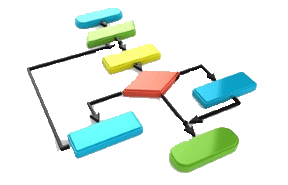Algorithmic Strategies
Based on the latest data, half of the trading volume of US stocks on the stock exchange is accounted for by algorithmic trading.

Today, thanks to algorithms, millions of transactions are made on the stock exchange and forex market using ready-made algorithms that can completely replace a person.
It is worth noting that with the help of specialized programs, traders have achieved tremendous speed in opening and closing orders, which has led to the development of high-frequency trading.
History of the development of algorithmic trading
It is no secret that before the 1970s, trading on the stock exchange took place like an auction, where crowds of traders gathered on specialized platforms, paying for a place and, practically speaking, carrying out their transactions.

This development of the stock exchange and communications gradually gave rise to the possibility of algorithmic trading, as an increasing number of stock exchange players began to abandon traditional trading on the floor, and preferred remote work in the office.
A special breakthrough in the development of algorithms and trading with the help of various robots occurred after IBM analysts published a report in 2001 on the advantage of an algorithm over a person and gave an example of how a simple strategy of providing an agent price had a great advantage over an inexperienced player.
It was the publication of this report, as well as the active connection of global exchanges into a single network, that gave a strong impetus to the development of this segment.
It is worth noting that by algorithmic trading we mean the use of algorithms and programs that have an algorithm for opening and closing transactions under certain conditions. It is worth noting that with the development of the global network, so-called high-frequency trading began to develop, the meaning of which is that the algorithm receives certain data before the trader, on the basis of which transactions are concluded with minimal risks.
Algorithmic strategies and their types
It is worth noting that algorithmic trading occupies the most competitive segment on the stock exchange, so in recent years trading has resembled a battle between algorithms and technologies.
Actually, those companies that have conquered this segment must constantly improve and modernize their algorithms, since such high competition leads to the rapid obsolescence of robots. For example, one of the companies that specializes in high-frequency trading lost more than $400 million in just 45 minutes due to an algorithm failure, and thousands of left orders had a fairly strong impact on the stock market, which shook confidence in the stock market due to manipulations with parties of such companies.
If we talk about strategies, they are conditionally divided into:
1) Arbitrage
Using algorithms, traders have the opportunity to conduct arbitrage operations, which are based on patterns of correlation of certain assets from the same or different segments.
Thus, having found a certain pattern in the movement, the algorithm performs arbitrage operations on divergence or convergence of price movements, which occur with a delay of a fraction of a second.
Thus, only with the help of advisors and algorithms can this kind of risk-free strategy be implemented. 2) Strategies based on anticipation
Many traders place their servers with algorithms near exchange buildings, which allows them to get maximum speed of order execution and access information on prices ahead of other exchange participants.
Thus, having an advantage in the speed of obtaining information and executing orders, traders build their strategies based on high-frequency trading. 3) Tactics of market makers
It is no secret that to maintain liquidity on any instrument, market makers are needed.
In the foreign exchange market, this category of companies using such strategies provide simply enormous liquidity, while leading the market the way they need. It is also worth noting that some companies pay a lot of money to create such liquidity on unpopular and illiquid instruments. Consequences of the development of algorithmic trading
As a result of the development of algorithmic trading, quite positive changes have occurred for the ordinary trader.
Such changes include very high liquidity on almost all major instruments, thanks to which you can always open your transaction at the stated price. Also, due to the competition of these companies, the value of the spread has narrowed quite significantly, which is good news.
However, it is worth noting that large market maker companies sometimes abuse and try to manipulate the market, which leads to requotes and unpredictable strong price changes, due to which stops are very often taken out. By the way, the appearance of the phrase “Taking out the crowd” appeared precisely with the development of algorithmic trading.
